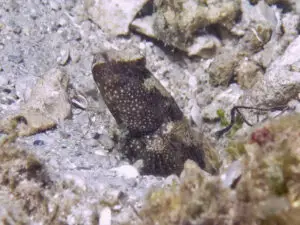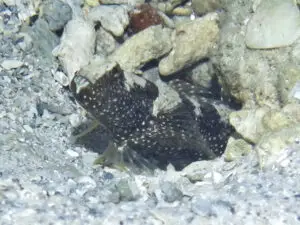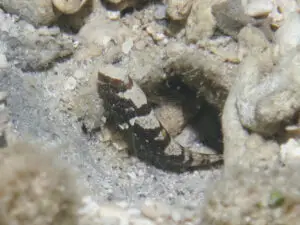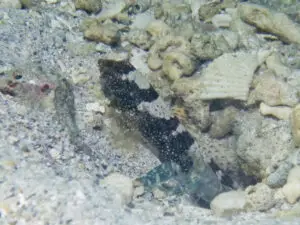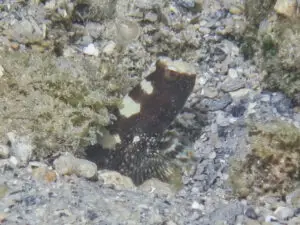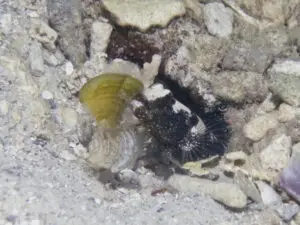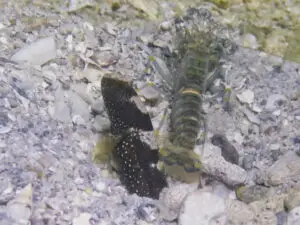Maude’s Shrimpgoby
Cryptocentrus maudae
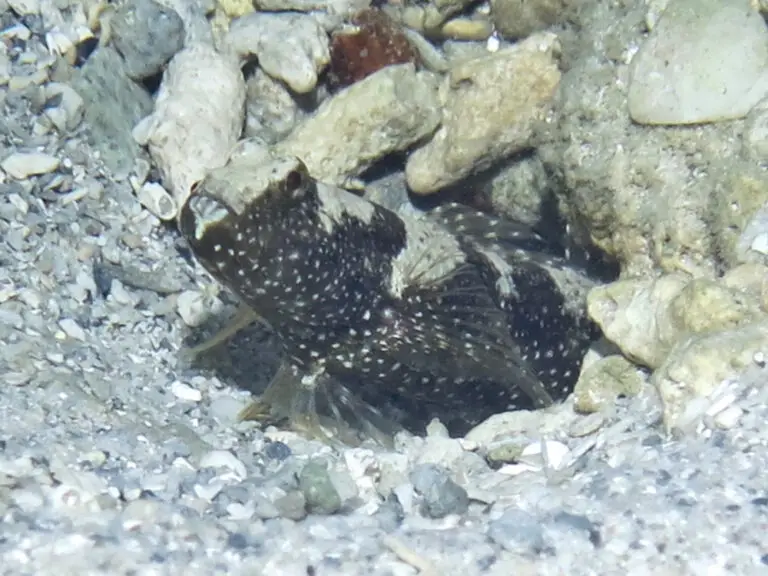
Maude’s Shrimpgoby
Cryptocentrus maudae
Fowler, 1937
Description
This is a medium-sized shrimpgoby, up to 10 cm in length.
Body design
The head is dark brown covered laterally and dorsally in randomly arranged white speckles. The front of the head is bright white. This white colour extends to the lower jaw in the form of four lines that join up to make a single line under the jaw. The nostrils are tubular.
The dorsum of the body is dark brown. On this are eight white dorsal saddles, the second of which is extended laterally to form a crescent. Some of the white patches have scattered black speckles making the saddles difficult to see. The lateral aspect of the body is brown with fine speckles, a continuation of the pattern on the head.
Fin design
The first and second dorsal fins are translucent with alternating white and brown spots on each fin ray.
The pectoral fins are translucent yellow. The rays are darker and are marked proximally with rows of white spots becoming more densely packed at the base. There is a conspicuous white spot just above the origin of this fin, just below the point of the crescent-shaped second dorsal saddle, but no large central white patch such as seen in C leucostictus.
The pelvic fin is boldly pattered in dark brown with rows of white spots that may become confluent.
The anal fin is pale grey diagonally banded with dark grey.
The caudal fin is translucent yellow.
Variation
The saddles on some individuals are grey-brown rather than white.
Diagnostic features
The white face and series of white saddles on a speckled background are conspicuous. The fish most likely to confuse is C leucostictus. They differ in body markings and the design of all the fins, It is not always easy to see these as all these black and white shrimpgobies tend to stay in the burrow entrance with only the head and pectoral fins visible. The white patch on the pectoral fin of C leucostictus is a useful point of differentiation.
Similar species
Cryptocentrus leucostictus has different body and fin markings in addition to the conspicuous white patch on the pectoral fins.
In Cryptocentrus albidorsus the white on the back is continuous. It has not been recorded from this region.
Natural History
Habitat
Maude’s Shrimpgoby lives in very shallow water, most commonly in the sand and rubble substrate adjacent to the roots of the mangrove Rhizophora, where there are about three under each tree. These areas are completely exposed at low tide at which time the burrow entrance is blocked by moist sand although its location remains obvious. This presumably maintains the burrow humidity and prevents discovery by eels and other hunters on the tidal flats.
Elsewhere they are known to inhabits tide pools, mud flats, and sheltered sand/rubble patches on inshore and coastal reefs to depths of about 10 m.
At Low Isles, the burrows have the form of a semicircle of large dead coral pebbles with, on the other side, a steep mound of excavated sand.
Behaviour
Maude’s shrimpgoby also has burrows in the algae-covered shallow water near the line of mangroves. This is a less severe habitat at low tide as it retains a couple of centimetres of water. The burrows are vertical shafts and at any disturbance the goby retreats tail first until only its head is exposed, looking remarkably like the pebbly sea bed
A second shrimpgoby species, Ctenogobiops aurocingulus is found in this habitat with Cryptocentrus maudae i
We have observed and photographed remarkable behaviour in which Maude’s shrimpgoby collected wood-shaving algae (Padina sp) from near the burrow and pulled several pieces into the entrance. We do not know the purpose of this. We have observed and photographed this goby seizing and devouring drifting fragments of vegetable matter but not anything as big as the wood shavings pieces. It may be intended for the shrimps but again there is an excessive amount. It may be used to plug the entrance so when the outgoing tide covers it with excavated sand this does not run in too great a quantity making it hard for the shrimp to dig them out on the return of the tide. Any of these explanations would be remarkable.
Distribution
Published distribution:
Sri Lanka to north-eastern Australia, north to Palau, Philippines, and Brunei; ranges throughout East Indian region except Solomon Islands.
AOL records from Australia at Daintree River mouth and Watson’s Bay, Lizard Island.
Our records:
Australia, Low Island, Queensland.
Associated Shrimp species
Associated Shrimps (one shrimp)
Pale Marbled Snapping Shrimp, Alpheus djiboutensis

